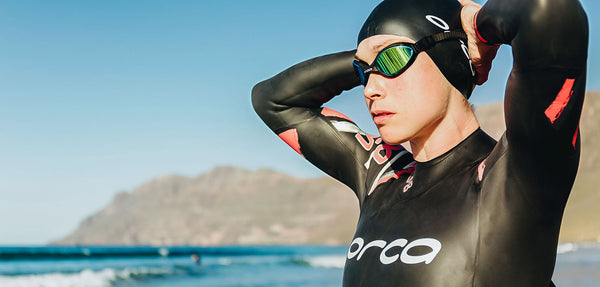Triathlon Wetsuit FAQ

Shop our Triathlon Wetsuits Here
Triathlon Wetsuits differ from surfing and diving wetsuits in that the physical demands of a triathlete are substantially higher than that of a surfer or a diver. Tri wetsuits are built not just to keep you warm but to assist in buoyancy, reduce drag and to provide specialised panelling that works to modulate your streamline and trim for better performance. Below is a series of FAQs we get through our channels here at Wetsuit Warehouse.
1. Which wetsuits are best for triathletes?
Next to buying your bike a wetsuit is going to be the most important piece of kit you need to compete in open water events. Triathletes have some unique requirements from wetsuits and this is why you cannot simply buy any old wetsuit off the hanger. Surfing, diving and water skiing wetsuits will not be flexible enough in most cases for long distance swimming. Triathletes need a triathlon wetsuitthat is highly flexible and offers a really comfortable fit.
2. Can you hire triathlete suits?
Some major events do operate their own fleet hire wetsuit stands. This is ideal for those people who are only intending to participate in one event in the year. You can also hire a triathlete wetsuit for the whole season if you want to. However although this can be much cheaper than buying a wetsuit the choices will not be very good and you could end up paying out if you damage the wetsuit whilst you are using it. If you do take part in a number of events during the year then it is best to buy your own triathlete wetsuit so that you can choose the right one for you. You will also not have to worry about returning it at the end of the season.
3. Are there any regulations for triathlete wetsuits?
There are a number of regulations you need to take into consideration before you buy a wetsuit. Firstly in nearly all events you will only be allowed to wear a wetsuit for open water events. This means no wetsuits in pool based competitions. You do need to check the guidelines for each event but in general you will not be able to use a wetsuit in the following circumstances in event conditions:
- For swims less than 2000m in temperatures greater than 21 degrees.
- For swims more than 3000m in temperatures greater than 23 degrees centigrade.
Wetsuits are limited to a 5mm thickness and many of the major brands provide suitable options.
4. Can I use boots and gloves with triathlete wetsuits?
Although you can train with boots and gloves for most events you will not be able to use these wetsuits accessories under competition conditions.
5. How do I choose the right triathlete wetsuit for me?
Think about your kick style when you are choosing a wetsuit. If you have a strong leg kick then you need less thickness on the legs of your suit. If you can withstand the cold well then you could even opt for a ‘shorty’ suit (short sleeve and short leg). If you have a poor kick or get cold very quickly then you should choose thicker leg sections and also opt for a thermal lining. If you are a very serious competitor then you may prefer to have special panels and zipper configurations so you can get the wetsuit off quickly without wasting too much time.
6. Should I opt for a bespoke triathlete wetsuit?
You can get wetsuits made to your individual requirements. This can be a good idea if you really cannot find an ‘off the peg’ wetsuit that fits well and offers the features you need. This can be a costly choice though and there is no guarantee that it will fit perfectly. If you are buying a bespoke wetsuit online then you will need to take the measurements yourself. It is essential you make sure the measurements are absolutely accurate otherwise you could end up with a suit that does not fit at all.
For the majority of triathletes a standard pre-made wetsuit should be suitable.
7. What is the best way to get my wetsuit on and off quickly?
Transitional periods can affect competition times dramatically so getting your wetsuit on and off quickly is essential for serious competitors. Some athletes use petroleum jelly to reduce chafing and ease transition. Unfortunately this substance degrades the synthetic neoprene used to make wetsuits so it is not a good idea to use this as it will ruin your suit. This is okay if you can afford a new wetsuit every other season but if you are on a budget then you could try using just a little bit of water based lubricant on the collars and cuffs to help ease the wetsuit off and prevent chafing. This will be less harmful to the rubber material.
8. How do I know if I have the right fit for my triathlete wetsuit?
Basically your wetsuit should be close fitting and tight enough that there are no baggy bits or wrinkles in the neoprene. One key area to check is the armpits and groin. Water can pool here on baggy wetsuits and this can be uncomfortable and will leach heat away from your body. The wetsuit should never be so tight that you cannot move your arms and legs without feeling the suit pull uncomfortably. This could restrict your swimming style.
9. Do I need to buy a wetsuit designed for my gender?
Triathlete wetsuits are available for both female and male body shapes. This is supposed to help provide a better fit across key areas such as the hips and chest. However the best wetsuit will be the one that fits you most comfortably. Plenty of women prefer men’s suits for their own personal body shape these provide the better fit. Pick the triathlete wetsuit that fits you best and try not to worry too much whether it is designed for particular genders.
10. What is the best way to put my triathlete wetsuit on?
A lot of damage can happen to wetsuits as you are putting them on, particularly from fingernails which can create nicks that can weaken the neoprene. Many wetsuit owners use a simple trick involving a plastic bag to help make it easier to get suits on. Simply put your foot in a plastic bag and the step into the leg of your wetsuit. Now pull the wetsuit up carefully up to the knee. Peel the bag off your foot and repeat this will the other leg. The bag acts as a barrier between your skin and the rubber and helps to reduce friction. Now you can roll the suit up to your waist and repeat the bag trick with your arms.


